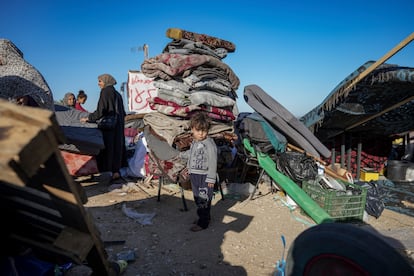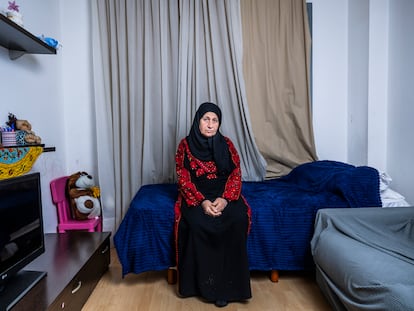Fleeing Rafah after Israel’s evacuation order: ‘It was a miracle that we got out of there alive’
A Gazan woman tells EL PAÍS that Israel ordered the move at the same time as it dropped bombs on the area, without giving the population time to get to safety. At least 80,000 people have escaped, according to the United Nations


The Israeli army leaflets ordering residents of the eastern part of Rafah to leave fell from the sky “at 9:30 a.m.,” estimates Amal, a 36-year-old Palestinian woman who did not want to give her real name. She can still not believe that she and her two children, aged 12 and 9, got out alive. According to Amal, the leaflets fell on what was her street at the same time as the bombs. “God saved us. It was a miracle that we escaped death, because there was no time to evacuate. I swear [the Israelis] didn’t give us time to leave. They announced the evacuation order and immediately began dropping bombs like crazy on the people,” she explains via WhatsApp messages. According to the U.N. Refugee Agency (UNRWA), at least 80,000 Palestinians have fled the southern area of Rafah since Israel ordered the evacuation on Monday.
Like Amal and her children, who had to escape their home in Gaza City in October, “most of those uprooted by Israeli military evacuation orders in eastern Rafah have already been displaced from other areas of Gaza,” the United Nations said in a statement on Thursday. They are now leaving with everything they can carry “in vehicles, trucks, [on] motorbikes and donkey carts,” according to the UNWRA, which estimates that more than 47,500 Palestinians left their shelters in Rafah on Wednesday alone.
Israel said on Monday that its evacuation order affected 100,000 people, but, according to other United Nations sources in Rafah, cited by The Guardian, far more than that number have already left the eastern part of the city, with the figure expected to rise to 300,000 in the coming days.
These figures do not seem exaggerated. The evacuation order covers an area measuring 12 square miles, and the population density in Rafah is 20,000 people per square mile, almost double that of New York City, according to UNICEF. Before the war, Rafah and its governorate had 220,000 inhabitants, but more than a million people are now living in the city after being displaced by Israel’s successive evacuation orders.
From the windows of the warehouse where Amal, her children and her husband had been living since October — their house was destroyed by a bombing — they could see the Rafah border crossing with Egypt. Since Tuesday, the crossing — the main entry route for humanitarian aid into Gaza — has been controlled by Israeli tanks. Israel’s control of the crossing, in addition to its evacuation order for the east of the city, are seen as the first steps of the feared Israeli ground offensive in Rafah. This invasion has not yet happened, at least not on a large scale.
“Israeli propaganda”
Amal’s neighborhood of Al-Geneina is at the heart of the nine areas of Rafah — Israel has divided Gazan territory into areas — that were ordered to evacuate on Monday. Although, until now, the southern city was defined as a “safe zone” by Israel, the Israeli army has never stopped bombing Rafah.
When the leaflets began to fall, Amal and her children did not have time to gather their already meager belongings, since the Israeli planes “immediately began dropping bombs,” she says. “I grabbed my children and started running down the street with other people from the shelter. The only thing I was thinking about at that moment was how to keep my children safe from the bombings. We escaped while the bombs fell around us, in the shelters and on the other houses in the area,” she remembers. “The evacuation orders are just Israeli propaganda intended for foreign media.”
Amal mentions the name of the street hit by the Israeli bombings that she and her children escaped from, along with other displaced people: “George Street.” On Monday, the official Palestinian WAFA agency reported shelling in the Al-Geneina neighborhood, which killed at least four civilians, including two children, and another airstrike on George Street. On that road, at least four other people died, one of whom was a minor.
Between Monday afternoon and Wednesday, Israeli attacks killed 109 Palestinians and injured 296, according to data from the Gaza Ministry of Health, which is controlled by Hamas. In the seven months since the war began, around 34,900 Palestinians have died in Gaza and another 78,404 have been injured, according to that source.
“We have never experienced terror like this Monday,” says Amal. “I can’t explain what we were feeling. We were running under shelling for two hours. I can’t believe we’re still alive. God has saved us.” Her husband also escaped unharmed. He stayed behind when his wife and children fled, trying to gather “some clothes and blankets to cover the children at night.” After five hours, the man was able to leave the neighborhood. Now, the whole family is taking refuge in “an old empty warehouse” on the other side of Rafah.
Sign up for our weekly newsletter to get more English-language news coverage from EL PAÍS USA Edition
Tu suscripción se está usando en otro dispositivo
¿Quieres añadir otro usuario a tu suscripción?
Si continúas leyendo en este dispositivo, no se podrá leer en el otro.
FlechaTu suscripción se está usando en otro dispositivo y solo puedes acceder a EL PAÍS desde un dispositivo a la vez.
Si quieres compartir tu cuenta, cambia tu suscripción a la modalidad Premium, así podrás añadir otro usuario. Cada uno accederá con su propia cuenta de email, lo que os permitirá personalizar vuestra experiencia en EL PAÍS.
¿Tienes una suscripción de empresa? Accede aquí para contratar más cuentas.
En el caso de no saber quién está usando tu cuenta, te recomendamos cambiar tu contraseña aquí.
Si decides continuar compartiendo tu cuenta, este mensaje se mostrará en tu dispositivo y en el de la otra persona que está usando tu cuenta de forma indefinida, afectando a tu experiencia de lectura. Puedes consultar aquí los términos y condiciones de la suscripción digital.
More information
Archived In
Últimas noticias
A survivor’s account of the Interoceanic Train accident: ‘We were scared because of the speed on the curve’
The Interoceanic Train, the Mexican alternative to the Panama Canal
What is known about the Interoceanic Train derailment in Oaxaca
Trump turns a Minnesota fraud allegation into ammunition for his MAGA army against Democrats
Most viewed
- Oona Chaplin: ‘I told James Cameron that I was living in a treehouse and starting a permaculture project with a friend’
- Reinhard Genzel, Nobel laureate in physics: ‘One-minute videos will never give you the truth’
- Why the price of coffee has skyrocketed: from Brazilian plantations to specialty coffee houses
- Pablo Escobar’s hippos: A serious environmental problem, 40 years on
- Chevy Chase, the beloved comedian who was a monster off camera: ‘Not everyone hated him, just the people who’ve worked with him’









































